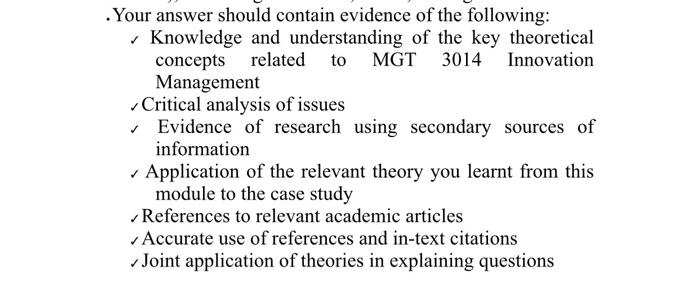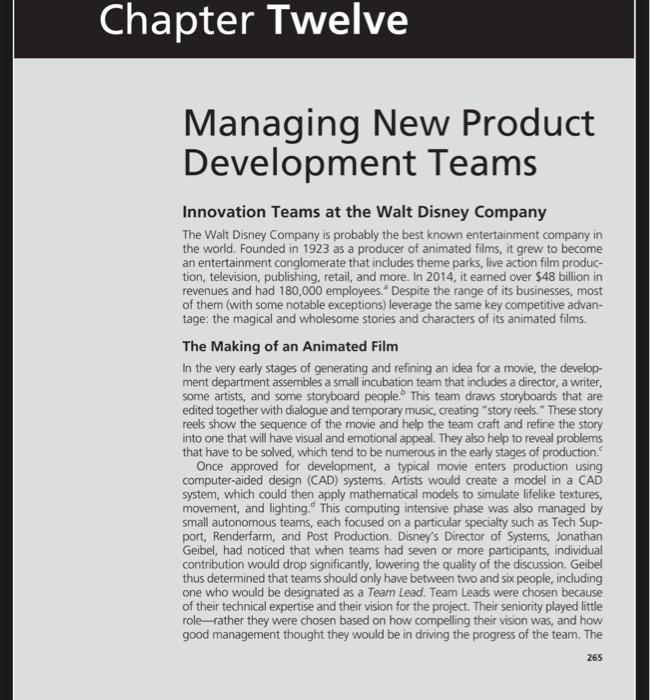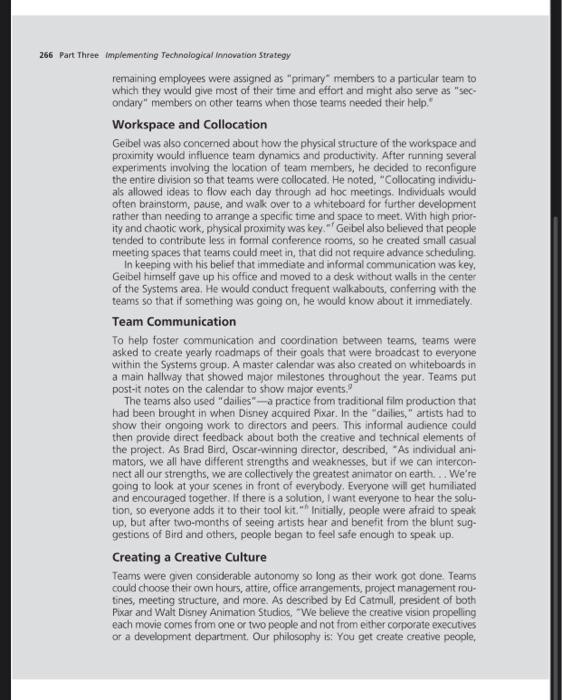Answered step by step
Verified Expert Solution
Question
1 Approved Answer
it is an assignment of module:- Innovation Management. read the case study given and answer the question with 1500 words. .Your answer should contain evidence
it is an assignment of module:- Innovation Management. read the case study given and answer the question with 1500 words. 




.Your answer should contain evidence of the following: r Knowledge and understanding of the key theoretical concepts related to MGT 3014 Innovation Management - Critical analysis of issues - Evidence of research using secondary sources of information - Application of the relevant theory you learnt from this module to the case study References to relevant academic articles r Accurate use of references and in-text citations Joint application of theories in explaining questions Question 2 Using the case study Innovation Teams at the Walt Disney (Schilling, 2017, pp. 265), discuss the way in which different types of team structure affect new product development process. Using information in the case study and from your own research, provide your own recommendations and limitations of the management of new product development teams. Innovation Teams at the Walt Disney Company The Walt Disney Company is probably the best known entertainment company in the world. Founded in 1923 as a producer of animated films, it grew to become an entertainment conglomerate that includes theme parks, live action film production, television, publishing, retail, and more. In 2014, it earned over $48 billion in revenues and had 180,000 employees." Despite the range of its businesses, most of them (with some notable exceptions) leverage the same key competitive advantage: the magical and wholesome stories and characters of its animated films. The Making of an Animated Film In the very early stages of generating and refining an idea for a movie, the development department assembles a small incubation team that indudes a director, a writer. some artists, and some storyboard people. This team draws storyboards that are edited together with dialogue and temporary music, creating "story reels." These story reels show the sequence of the movie and help the team craft and refine the story into one that will have visual and emotional appeal. They also help to reveal problems that have to be solved, which tend to be numerous in the early stages of production." Once approved for development, a typical movie enters production using computer-aided design (CAD) systems. Artists would create a model in a CAD system, which could then apply mathematical models to simulate lifelike textures, movement, and lighting. . This computing intensive phase was also managed by small autonomous teams, each focused on a particular specialty such as Tech Support, Renderfarm, and Post Production. Disney's Director of Systems, Jonathan Geibel, had noticed that when teams had seven or more participants, individual contribution would drop significantly, lowering the quality of the discussion. Geibel thus determined that teams should only have between two and six people, including one who would be designated as a Team Lead. Team Leads were chosen because of their technical expertise and their vision for the project. Their seniority played little role-rather they were chosen based on how compelling their vision was, and how good management thought they would be in driving the progress of the team. The 265 implementing Technological innovation Strategy remaining employees were assigned as "primary" members to a particular team to which they would give most of their time and effort and might ako serve as "secondary" members on other teams when those teams needed their help." Workspace and Collocation Geibel was also concerned about how the physical structure of the workspace and proximity would influence team dynamics and productivity. After running several experiments imvolving the location of team members, he decided to reconfigure the entire division so that teams were collocated. He noted. "Collocating individuals allowed ideas to flow each day through ad hoc meetings. Individuals would often brainstorm, pause, and walk over to a whiteboard for further development rather than needing to arrange a specific time and space to meet. With high priority and chaotic work, physical proximity was key. "f Geibel also believed that people tended to contribute less in formal conference rooms, so he created small casual meeting spaces that teams could meet in, that did not require advance schedulng. In keeping with his belief that immediate and informal communication was key, Geibel himself gave up his office and moved to a desk without walls in the center of the Systems area. He would conduct frequent walkabouts, conferring with the teams so that if something was going on, he would know about it immediately. Team Communication To help foster communication and coordination between teams, teams were asked to create yearly roadmaps of their goals that were broadcast to everyone within the Systems group. A master calendar was also created on whiteboards in a main hallway that showed major milestones throughout the year. Teams put post-it notes on the calendar to show major events.? The teams also used "dailies" - a practice from traditional film production that had been brought in when. Distey acquired Pixar. In the "dailies," artists had to show their ongoing work to directors and peers. This informal audience could then provide direct feedback about both the creative and technical elements of the project, As Brad Bird, Oscar-winning director, described, "As individual animators, we all have different strengths and weaknesses, but if we can interconnect all our strengths, we are collectively the greatest animator on earth... We're going to look at your scenes in front of everybody. Everyone will get humiliated and encouraged together, If there is a solution, I want everyone to hear the solution, 50 everyone adds it to their tool kit. "i initially, people were afraid to speak, up, but after two-months of seeing artists hear and benefit from the blunt suggestions of Bird and others, people began to feel saie enough to speak up. Creating a Creative Culture Teams were given considerable autonomy so long as ther work got done. Teams could choose their own hours, attire, office arrangements, project management routines, meeting structure, and more. As described by Ed Catmull, president of both Pixar and Wait Disney Animation Studios, "We believe the creative vision propelling each movie comes from one or two people and not from either corporate extcutives or a development department. Our philosophy is: You get create creative people, Chapter 12 Managing New froduct Development Teams 267 you bet big on them, you give them encrmous leeway and support, and you provide them with an enwironment in which they can get honest feetback from everyone.". Initially, it was not always easy for the engineers to embrace this kind of autonomy-they tended to continue to ask permission about minor aspects of team organization. As Geibel noted, "We've built teams where technical leads don't have to ask for permission to change the way they are running their teams... We're still working on people thinking that wey spontarieously. The culture is ingrained in everybody because the average tenure is 1540 years. If you've worked in a top-down organization for that long, it's going to take a while to adapt to a new culture where everyone is expected to challenge the statur quo and where there's an expectation that critical thinking is hagpening at all levels." Discussion Questions: 1. Why does Disney keep its developinent teams small? 2. What are the pros and cons of the teams being $0 autonomous? 3. Is Disney's team approach mostly suited to creative projects, or would it work equally well in other kinds of industries? "Swncheovetacem Sohool Q0t5. May 1 aht * Edrondion, AC, Aget, DL, Habug, L. and llariely, N. Teiming at Daney Ammabor, haned tururees School 2015t May teth. Schoor (2015). Man 186. School Q0t5L, May Them. A Kao, H, Sution- k, and Webb, ap "isnowition lesors from Faar An mesesw ath Oscie-wincing dienctor irad Bed, -Mekiney Quartety, Aprit \&cCg. VERVIEW New product development often requires activities that are the responsibility of different departments within the organization. To facilitale coontination and cocperation across division boandaries, masy organizations create cross-functional ncw product development teams to lead and mannge the development process for the project. There is considerable variation, however, in how teatms are formed and manapcd. In this chapter, we will look at several factors that affect the new product develogensent feam's performance, including its size, composition, structure, administration, and leaderstaip. ONSTRUCTING NEW PRODUCT DEVELOPMENT TEAMS In constructing new prodact development teams, the orgainication thust coesider how the team's sine and composition will affect its mix of skilk, its access lo tesources, and its effectivencss in providing communication and coovilinatioe across the divisions 




Step by Step Solution
There are 3 Steps involved in it
Step: 1

Get Instant Access to Expert-Tailored Solutions
See step-by-step solutions with expert insights and AI powered tools for academic success
Step: 2

Step: 3

Ace Your Homework with AI
Get the answers you need in no time with our AI-driven, step-by-step assistance
Get Started


